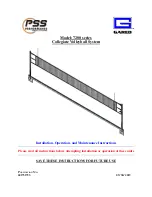
IT
EN
Remember that:
• the checks must be carried out by qualified personnel
• as lifting accessories, the RPL type rotating eyebolts with
bearing must be subjected to scheduled periodic checks and
recorded in a special control register in compliance with the
standards and laws in force
• the rotating eyebolt must be installed by qualified personnel
as it is used for lifting operations that must be carried out in
accordance with the machinery directive 2006/42 /EC and
subsequent amendments.
• the qualified person who must supervise the lifting operation
must always identify the center of gravity of the load and
position the rotating eyebolts in order to ensure that the load
is always balanced
• in case of asymmetrical load consider a reduction of the
capacities as indicated in the reference table
• check the suitability of the resistance class of the nut intended
to house the rotating eyebolt in relation to the load to be lifted
(the material of the nut must have a tensile strength equal or
greater than that of S235JR steel - reference standard EN
10025)
• the depth of the threaded hole must be at least
1 x d for steel
1.25 x d for cast iron castings
2 x d for aluminum alloys
2.5 x d for aluminum-magnesium alloys
• The threaded hole must be perpendicular to the supporting
surface
• Check that the support surface of the screwed nut is suitable
for flatness and dimensions in order to ensure the support
of the entire flat surface of the rotating eyebolt and that it
adheres adequately
• It is prohibited the use of the rotating eyebolt if the whole
surface does not adhere to the load to be lifted
• To install the rotating eyebolt it is sufficient to manually
tighten the screw with a hex key without the aid of extensions
(do not exceed the tightening torques indicated in the table);
for disassembly proceed in the opposite direction
• Tighten the screw until the rotating eyebolt adheres
completely to the support surface
• Once tightened, check that the bulb rotates freely and without
hindrance and that the welded ring is always oriented in the
direction of the load
• The device is suitable for rotation under load only in the
axial pulling condition; the eyebolt can in any case be
used in all other pulling direction without rotation (for the
WLL see the reference table). When rotating under load,
do not exceed 50 rpm.
Istruzioni d’uso e di sicurezza
Operating and safety instructions
GOLFARI GIREVOLI TIPO RPL CON CUSCINETTO
ROTATING EYEBOLTS WITH BEARING TYPE RPL
Si ricorda che:
• i controlli devono essere effettuati da personale qualificato
• in quanto accessori di sollevamento i golfari girevoli con
cuscinetto tipo RPL devono essere sottoposti a verifiche
periodiche programmate ed annotate in un apposito registro
di controllo in conformità alle norme e leggi vigenti
• il golfare girevole RPL deve essere installato da personale
qualificato in quanto utilizzato per operazioni di sollevamento
che devono essere effettuate in accordo alla direttiva
macchine 2006/42/CE e successive modifiche.
• la persona qualificata che deve sovraintendere l’operazione
di sollevamento dovrà sempre individuare il centro di gravità
del carico e posizionare i golfari in modo da garantire che il
carico sia sempre bilanciato
• in caso di carico asimmetrico considerare una riduzione delle
portate come indicato nella tabella di riferimento
• verificare l’idoneità della classe di resistenza della madrevite
destinata ad alloggiare il golfare in rapporto al carico da
sollevare ( il materiale della madrevite deve avere una
resistenza a trazione uguale o maggiore a quella dell’acciaio
S235JR – norma di riferimento EN 10025)
• la profondità del foro filettato deve essere minimo
1 x d per l’acciaio
1,25 x d per fusioni di ghisa
2 x d per leghe di alluminio
2,5 x d per leghe di alluminio-magnesio
• Il foro filettato deve essere perpendicolare alla superficie di
appoggio
• Verificare che la superficie di appoggio della madrevite sia
idonea per planarità e dimensioni in modo da garantire
l’appoggio di tutta la superficie piana del golfare e che la
stessa aderisca in modo adeguato
• È vietato l’uso del golfare con parte della base di appoggio a
sbalzo
• Per l’installazione del golfare è sufficiente procedere
manualmente al serraggio della vite con chiave esagonale
senza l’ausilio di prolunghe (non superare le coppie di
serraggio indicate in tabella); per lo smontaggio procedere
nel senso contrario
• Serrare la vite fino a fare aderire completamente il golfare alla
superficie di appoggio
• Una volta effettuato il serraggio verificare che il golfare ruoti
liberamente e senza impedimenti
• Una volta effettuato il serraggio orientare l’anello del golfare
nella direzione del carico
• Il dispositivo è idoneo alla rotazione sotto carico solo
nella condizione di tiro assiale; il golfare è comunque
utilizzabile in tutte le altre direzioni di tiro senza rotazione
(per i carichi vedere la tabella di riferimento).
• In fase di rotazione sotto carico non superare i 50 giri/
minuto.
Corretto
Right
Errato
Wrong
3
M-RPL-2109-00


























